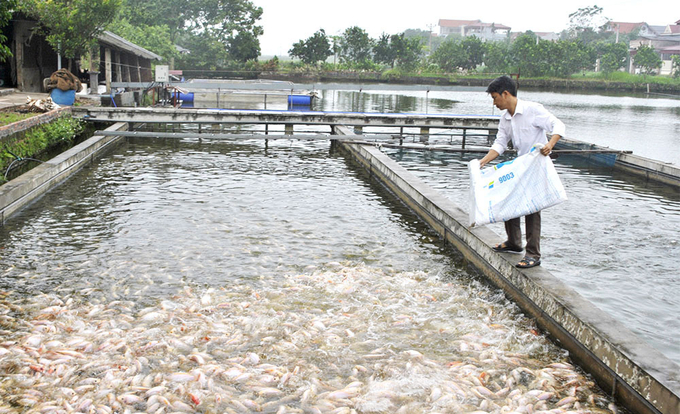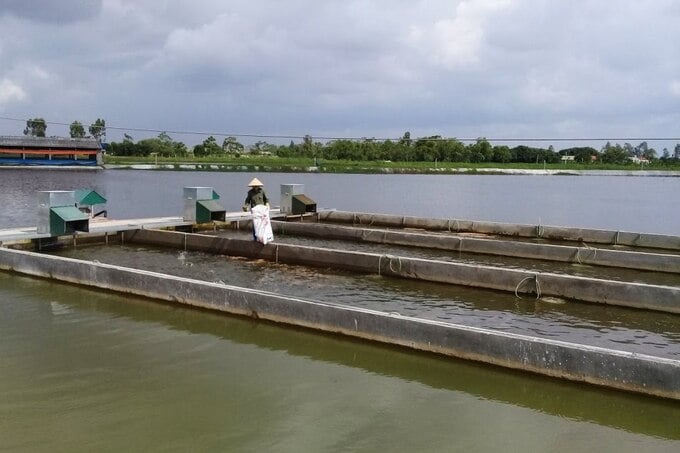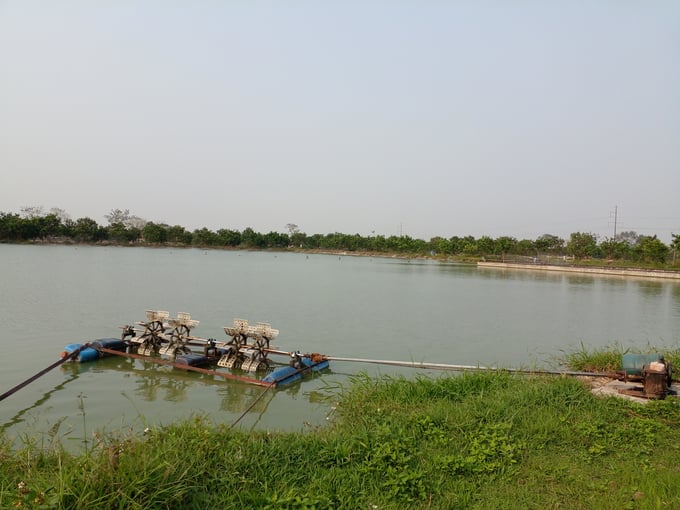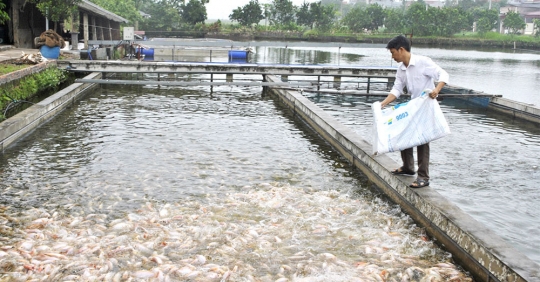In 2018, Mr. Dang Van Duan from Luu Khe Village, Lien Bat Township (Ung Hoa, Hanoi) was invited by the district agricultural extension station to visit models of high-tech aquaculture applications in Hung Yen and Hai Duong provinces. After listening to fisheries officials share techniques for raising river fish in ponds, he found that this model has many outstanding advantages over the traditional method of fish farming.
After Mr. Duan mastered the management techniques and operating principles of the river fish farming model in ponds, he applied for breeding by this method with an area of 2 ha and was approved by the Economic Department, Agricultural Extension Station, Lien Bat Commune People’s Committee is very interested and supportive.

The flow technology in ponds enables management with a density 10 times higher than in conventional ponds.
The density is 10 times higher than the normal pond, you can harvest at any time
The “river in a pond” principle means using machines and devices to create a continuously flowing river in a standing pond. As a result, the fish swim upstream like in a river, so that the fish is always active and well trained. The advantage of this model is that it helps farmers to easily deal with the environment, diseases and high fish production, and the camera system helps farmers not to worry much. The system of feeding, waste treatment, harvesting … is completely closed and does not take much time.
“By creating a flow in a pond, fish can live in a cage-like environment in a river, but without being exposed to mud and pathogens. The density of fish raised in the tank is 10 times higher than in a regular pond. Many different species of fish can be raised, and the fish grow quickly,” Mr. Duan said.
In the past in traditional farming, when a customer ordered fish, if he had to hire someone to pull the net no matter how little or how much he fished, a catch had to hire 4-6 people with a salary of VND 250,000/person /Day. Now, growing in tanks according to the technology of rivers in ponds, customers can easily harvest whether they order a few tens of kg/time or a few quintals/time. On the other hand, fish that are raised in clean tanks are regularly aerated and vacuumed so that there is no fishy smell.
“This cultivation method is many times more effective than conventional agriculture. The biggest advantage is that the water is always circulating, less pollution, less disease, so the fish kill rate is only about 5%. The fish is always on the move, so the fish meat is tougher, tastier, and the products have sold out wherever they are made,” said Mr.

Fish farming using flow technology in ponds can actively control waste, help the pond environment to be very clean, and beneficial fish to suffer from diseases.
Mr. Duan shared that in order to implement this model, farmers must meet strict water surface requirements and conditions, understand the process of operating machines, cultivation techniques, etc. On an area of 2 hectares he built 2 tanks with hard concrete floors with the size of each tank 5m wide, 25m long, 2m deep, sloping towards the stern and with a manure treatment system at the end of the tank.
The initial investment cost of each tank is about VND 150 million. Accordingly, each aquarium is installed with a closed system of engineering equipment such as shaft generators, air compressors, oxygen supply aerators, water fans, bottom suction systems, etc., which flow continuously in the pond.
According to Mr. Duan, the model of rearing river fish in ponds requires farmers to pay attention to the rearing environment, not allow ducks to graze in ponds, and use microbial products to clean the soil every 6 months. In order to design the river in accordance with the depth standards to ensure the volume of water, a machine for suction of manure and excess waste must be arranged at the end of the river to ensure the water environment and power supply to be stable.
In this technology, the most important point is that the farmers have to maintain an air blower that can provide enough oxygen to the fish 24/7. If the power goes out, there must be a backup generator to ensure the air-blowing system is always working. Also, regularly check and clean the filter mesh, membranes and air blowers to ensure the water flow is always circulating in the river system.

The aeration system must be active at all times to keep oxygen in the pond.
With the air compressor system that helps release toxic gas, and at the same time, the compressed air at the bottom of the tank also creates a flow that pushes the waste aside and settles in the static tank behind, increasing the dissolved oxygen content Water soluble helps farmers fish to grow with high density and grow many crops in one year, so the productivity and output is also 2-3 times higher than ordinary ponds.
Clean fish, firm, tasty meat
Sharing the remarks on raising fish in ponds using flow technology, Mr. Duan said, “During the fish farming process, I use absolutely no banned substances regulated by the state, and carefully at reputable sites already in the breeding stage. Breeds must be healthy, swim flexibly, without deformities and disease free.
Fish food must be of good quality and stored in a high, dry and cool place to avoid mold. The aquariums are used every 6 months with microbial products to clean the bottom. For water, sample it once a month to have the pH checked by experts. This ensures that the living environment and diet of the fish grow well and the risks are limited.

Fish waste and feces are collected daily, and Mr. Duan uses probiotics to make fertilizer for plants.
The area of the river-forming basin is in the ratio of 1/20 to the pond, the maximum number of farmed fish can be stocked at a density of 7,000 fish/tank/ha; The rest of the pond is stocked with omnivorous fish to make use of the excess food. With the model of flow technology in the pond, the temperature in the pool is always maintained at 28 – 30°C, the pH in the water is suitable for fish growth from 5 to 6 and the dissolved oxygen content is 4mg/l. The water is circulated regularly, so it is cool in summer and not cold in winter. Especially with the amount of waste and fish droppings collected daily, Mr. Duan takes advantage of probiotic fermentation and then uses it as fertilizer for plants in the garden.
At the family fish farm, Mr. Duan also registered to use the VietGAP standards, which he applied in accordance with “4 Fixed”: fixed feeding position, correct amount of feed, fixed meal time, quality fixed amount of bran (stable).
To take the initiative in the food source for fish, Mr. Duan grows elephant grass, banana trees and cassava in the garden surrounding the farm. Elephant grass, banana leaves for carp, and cassava and banana stalks are chopped for other fish such as carp, unisexual tilapia, sesame, and drift. In addition, to understand the development of the fish, Mr. Duan often uses a meticulous notebook about feed dosage, growth period, common diseases…

The pond environment is always kept very clean.
Regarding the feeding regime, fish are fed 3 meals a day at set times: 8 – 9 a.m.; noon 12pm – 1pm; afternoon 4 – 5 p.m. Depending on the weather and the appetite of the fish, he adjusts the diet accordingly. In addition, according to the size of the fish, growth stage, frequency, amount of food, protein, vitamin C and digestive enzymes are suitable to increase digestion, increase resistance and achieve good resistance to adverse environmental conditions.
“Fish farming by flow technology in ponds has many advantages, such as: B. the ability to adjust weather and climate conditions, especially clear and clean water, and standard oxygen and pH levels in the water. The water source is not affected by external factors, so the fish is clean, the fish meat is delicious, especially without metal and chemical residues in the fish. This is the key point in creating a brand for raising river fish in ponds,” said Mr.
Each year Mr. Duan’s family farms 2 litters on an area of 2 ha and supplies the market with 60 tons of fish including carp size 4-5 kg/fish which is sold at VND 55,000/kg; Carp, sesame, pods 3-4 kg/head are sold at VND 44,000/kg. After deducting all expenses, his family earns about VND 280,000 million/year.
Due to the effectiveness of the fish farming model based on the flow technology in the pond, Mr. Duan plans to expand the breeding area in the near future and is willing to share his experience with households in the area who need to breed fish by this method… it is france.

